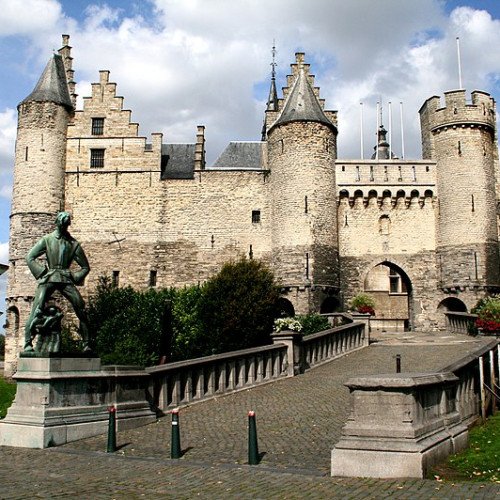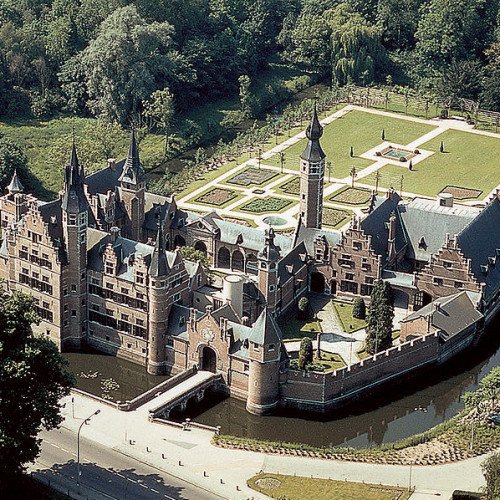Castles of "Belgium" HET STEEN vs STERCKSHOF

HET STEEN
Het Steen is a medieval fortress in the old city centre of Antwerp, Belgium, one of Europe's biggest ports. Built after the Viking incursions in the early Middle Ages as the first stone fortress of Antwerp, Het Steen is Antwerp's oldest building and used to be its oldest urban centre. The words "Het Steen", are dutch for The Rock. Previously known as Antwerpen Burcht (fortress), Het Steen gained its current name in around 1520, after significant rebuilding under Charles V. The rebuilding led to its being known first as "'s Heeren Steen" (the King's stone castle), and later simply as "Het Steen" (the stone castle). The Dutch word "steen" means "stone", and used to be used for "fortress" or "palace", as in the "Gravensteen" in Ghent, Belgium. The fortress made it possible to control the access to the Scheldt, the river on whose bank it stands. It was used as a prison between 1303 and 1827. The largest part of the fortress, including dozens of historic houses and the oldest church of the city, was demolished in the 19th century when the quays were straightened to stop the silting up of the Scheldt. The remaining building, heavily changed, contains a shipping museum, with some old canal barges displayed on the quay outside. In 1890 Het Steen became the museum of archeology and in 1952 an annex was added to house the museum of Antwerp maritime history, which in 2011 moved to the nearby Museum Aan de Stroom. Here is also a war memorial to the Canadian soldiers in World War II. At the entrance to Het Steen is a bas-relief of Semini, above the archway, around 2nd century. Semini is the Scandinavian God of youth and fertility (with symbolic phallus). A historical plaque near Het Steen explains that women of the town appealed to Semini when they desired children; the god was reviled by later religious clergy. Inhabitants of Antwerp previously referred to themselves as "children of Semini". An organization concerned with the historic preservation of Het Steen and Semini, Antwerp Komitee Semini in Ere (AKSIE), formed in 1986, holds annual celebrations at Het Steen as cultural events.
Statistics for this Xoptio

STERCKSHOF
The Sterckshof castle is in Deurne, Antwerp, Belgium. From 1994 to 2014 it housed the Sterckshof silver museum of the Province of Antwerp. Built on the site of a much older castle, or great house, the present building is a reconstruction erected in the 1920s. Sterckshof is about 6 kilometres (3.7 mi) east of Antwerp city centre. It is situated at an altitude of 3 metres (9.8 ft) above sea level. From as early as the 13th century the site of the castle was occupied by the fortified "Hooftvunder" farmhouse, surrounded by a moat. It was probably used to defend a nearby wooden bridge over the Grote Schijn River. In 1523 it was described as a farm with a house, brewery, moat, ponds, fishery, etc. That year it purchased by Gerard Sterck, who put up picturesque buildings with a castle, towers and turrets, and called it Sterckshof, a name it retains today. Gerard's grandson was Guillaume de Berghes, bishop of Antwerp. In Sterck's monument in Antwerp cathedral he is described as a knight, and lord of Busquoy, Wyneghem, Casterlé and Hooft-Vundere. Sterck was a merchant, banker and adviser to Emperor Charles V. Another owner, Jacob Edelheer, furnished the castle with art collections and scientific collections. Unlike other castles in Antwerp, the Sterckshof was not destroyed during the wars of the 16th and 17th centuries, but it was neglected during a dispute between the heirs after the owner, Jacob van Lemens, died childless in 1664. From 1693 Sterckshof was owned by the Jesuits of Lier, but the castle was damaged or allowed to deteriorate during the war of the Austrian Succession (1740-1748). After the dissolution of the Jesuit Order, the estate was sold in 1776 to the banker Jan Baptist Cogels, who merged it with his Ter Rivieren estate.